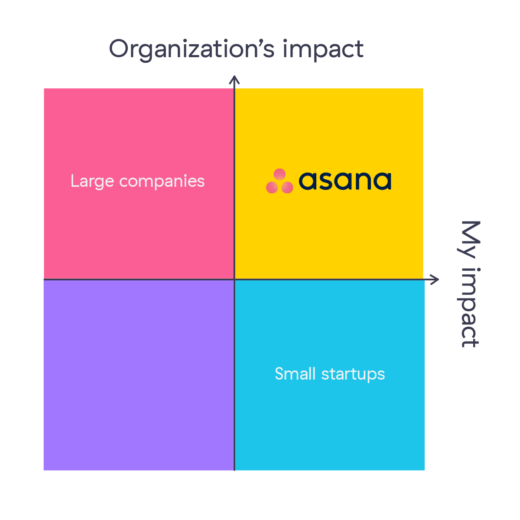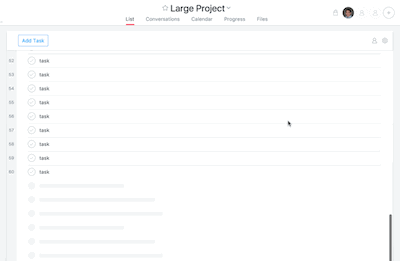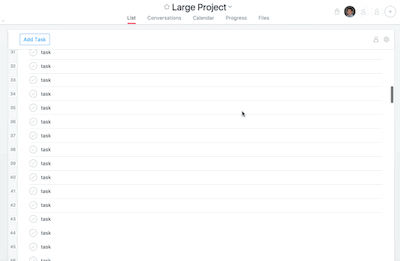What Product Managers do at Asana: An intern’s perspective
Each year, we welcome a couple product management interns to join our team. They, like our engineering and business interns, take on core work and spend their summer contributing to our product roadmap and business success.
As this summer came to a close, one intern approached us. He was interested in telling the story of how he came to be a PM intern and what he worked on during the summer. We considered adjusting it to tell it from our perspective but felt that he told it best. So here’s his perspective on product management at Asana.
What should I be when I grow up?
When I turned 10 years old, I wanted to be an author. Or a doctor. Or a board game inventor. When I turned 20, I still couldn’t make up my mind. Should I be a film producer or a teacher? A poet or event planner or data scientist?
I was majoring in symbolic systems (computer science + linguistics + psychology + philosophy). I was minoring in creative writing. I loved too many things to pick a single career. Then I learned about product management.
What exactly does a product manager do?
The role sounded like a perfect combination of my interests: research, writing, public speaking, data analysis, and more. I could use my technical skills, but wouldn’t be sitting in front of a computer all day.
What exactly would I be doing all day? I asked a product manager, “What does your typical day look like?” She responded, “It depends on the day.” So I asked, “Can you walk me through yesterday?” She provided a vague, intriguing description.
Can I become a product manager?
On January 19, 2017, I was wandering through a campus career fair, clutching a dozen resumes in a manilla folder. I entered a large tent, packed with rows of tables and swarms of students. A bright red-orange banner, with three dots in a triangle, hung over the first table.
I knew that company! We used Asana to track work at the Stanford Storytelling Project. I introduced myself to Katie Guzman, one of Asana’s product managers. We chatted briefly. I handed her my resume, then moved on.
I didn’t know if I was qualified:
- Am I technical enough? I’d taken half a dozen computer science classes. But I hadn’t ever been a software engineer.
- Am I outgoing enough? I enjoyed spending time with people, running meetings, and coordinating between team members. But I had an introverted side.
- Am I decisive enough? I enjoyed weighing pros and cons to make decisions. But I sometimes lingered over tough calls.
A take-home exercise and phone screen later, I found myself interviewing at Asana’s San Francisco office. During one interview, I asked how product management at Asana differs from other companies. My interviewer gave an insightful response, adding, “If you want to know more, I wrote a whole chapter about this in my book.”
Only then did I realize that I was talking to Jackie Bavaro, the author of Cracking the PM Interview. She had written the book on product management. In person, she ended up being a lot less intimidating—and a lot more helpful and funny—than I expected.
On June 20, 2017, I started as a product management intern at Asana. I guess I was qualified enough—just because “product management Intern” included the word “Management” didn’t mean I needed to start off as an expert. A handful of technical classes was enough. Having an introverted side was fine. And learning how to make hard, fast, informed decisions was an area where I could—and did—improve.
What is it like being a product manager at Asana?
Here are the five elements that surprised me most:
Quantity and quality of mentorship
As an intern at Asana, I received multiple hours of 1:1 mentorship each week. I had both a PM manager (Katie from the career fair) and a PM mentor. I sat next to my mentor, worked on projects alongside him, and was always able to turn to him for advice. (His first name also happened to be Louis!)

The other PMs taught mini-lessons on various topics (e.g. “How To Write an Effective Spec,” “A/B testing,” and “Incremental Development”). They helped me brainstorm ideas and shared feedback on my project briefs and specs.
I also received considerable mentorship from people I wouldn’t have expected. Justin Rosenstein, our co-founder, went on a walk with me during my first week. Jackie, the PM lead, consistently shared insightful feedback. And all interns, like full-time employees, could attend free sessions and leadership training with personal coaches.
Culture
I had read great things on Glassdoor. I didn’t think the reviews could possibly be true. But they were. (Also, the food is so good!)
Level of responsibility
I was only a PM intern, but everyone treated me like a full-time employee. From day one, I received a lot of responsibility and autonomy. I wasn’t confined to a little box in a corner. The features I’ve worked on have affected every Asana user. Alongside my PM mentor, I could choose which features to implement and when to ship them.
I believe that impactful work exists on two axes. In one direction, there’s how much your company is contributing to the world. In another, there’s how much you’re contributing to the company. The goal is to find work in the upper right quadrant.

Asana has over 25,000 paying users. Another company might have more users, but less room for personal impact. At Asana, I easily made major changes that impacted all our users; I wasn’t just a cog in the machine.
What I worked on each day
Each day at Asana was interesting and challenging. As a PM, my days consisted of:
- Holding user research sessions
- Conducting competitive analysis
- Defining goals, hypotheses, and success metrics
- Writing specs
- Brainstorming a wide variety of solutions
- Determining which features to prioritize
- Scoping the MVP (Minimum Viable Product)
- Keeping everyone on the same page via Asana tasks and conversations
- Meeting with all stakeholders
- Empathizing with users—rooting every goal and conversation in their needs
- Asking questions (Can we do it faster? Is it worth it? What if we do x instead?)
- Helping QA (Quality Assurance), considering edge cases, and collecting internal feedback
- Running A/B tests, setting expectations, and analyzing results
- Weighing tradeoffs—combining data, user research, competitive analysis, and intuition
- Iterating on the MVP
- Making ship or no ship decisions
- Coordinating rollout plans
I’d done bits and pieces of the above process before Asana, but I certainly hadn’t tied all the steps together in a single role. The days sped by. I learned more than I could have imagined in the short twelve weeks of my internship. At the beginning, I felt unqualified for the role. By the end, I felt competent juggling multiple features at once, driving them all the way from inception to completion.
The range of people I got to work with
When I first arrived, there were already coffee chats scheduled with designers, engineers, user experience researchers, data scientists, marketers, and other people from across the company. I worked primarily on the Performance team (making Asana faster), as well as the Admin Empowerment and Contributor Adoption teams. In my different projects, I got to work directly with more than 50 team members. Everyone was incredibly friendly and welcoming. They were smart, fun, and trusting.
Using Asana ourselves – assigning tasks to keep everyone on the same page – made coordinating between so many people seamless. Unlike previous jobs, there wasn’t an endless stream of emails. In fact, the only time I ever had to check email was when contacting users.
What features did I get to work on?
I would be a much worse PM if I didn’t care about the product. Fortunately, I had the opportunity to work on some really cool stuff:
- Deprecations: We removed a hack that made Asana slow. This deprecation went really smoothly, but took a lot of planning. So we established a process to make future deprecations even easier.
- Faster Scrolling: Scrolling through Asana used to be painfully slow, especially for users with large projects. We experimented with how early to load tasks and how many to load at
a time. We ran an A/B/C/D test, then shipped the best variant.


- Object Duplications: Object duplications—copying tasks and projects—used to be slow and confusing. We sped up small duplications. We started redesigning the UX to make the process clearer. And we came up with a plan to speed up large duplications.
- In-Product Education: Previously, when new users showed up in Asana, they saw a blank “My Tasks” page. We designed and began testing various types of in-product education.
- Keyboard Shortcuts Menu: We redesigned the Keyboard Shortcuts Menu. The other PM intern worked on this before the end of his internship, then I helped carry it through the finish line.
- And other highlights! I also worked on other elements of Asana. For example, I helped with the SSO login experience. And I calculated how much time performance improvements from the past year have collectively saved our users per day—more than 4.5 million seconds per day, or 50 days per day! When we completed a year-end performance objective early, we threw a party to celebrate. I helped plan and brainstorm ideas (including a race track and live bunnies).
Can you become a product manager?
I didn’t know if I could become one, but I threw in an application to find out. You can apply, too.